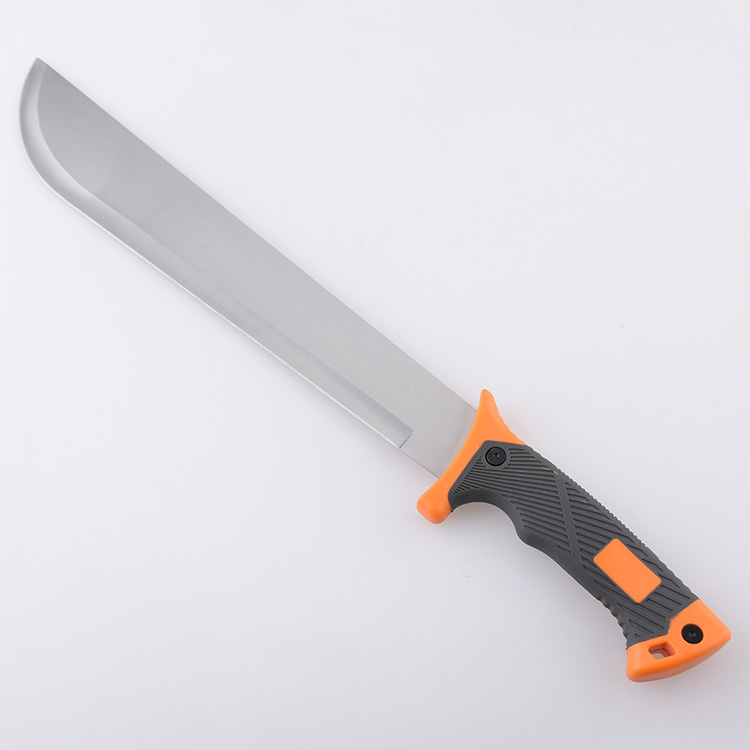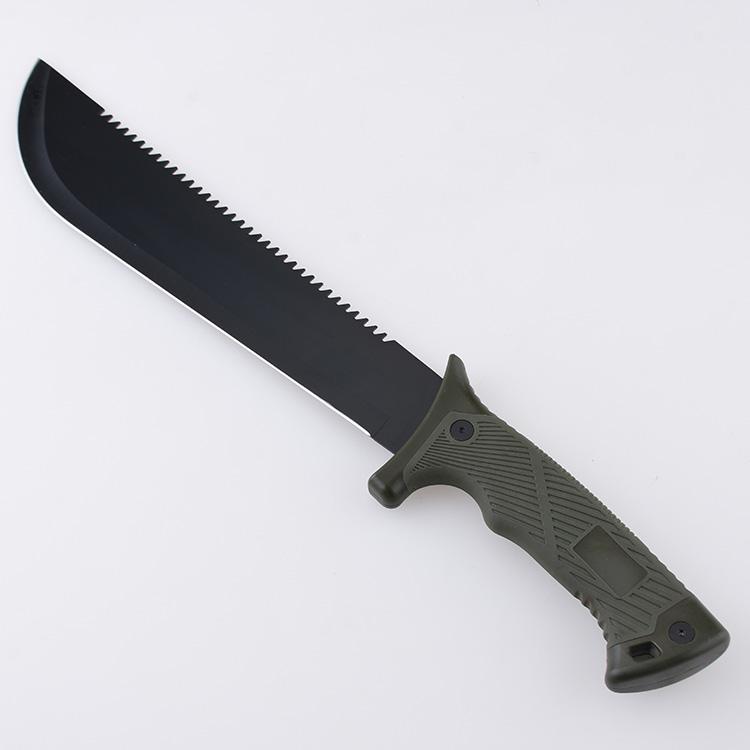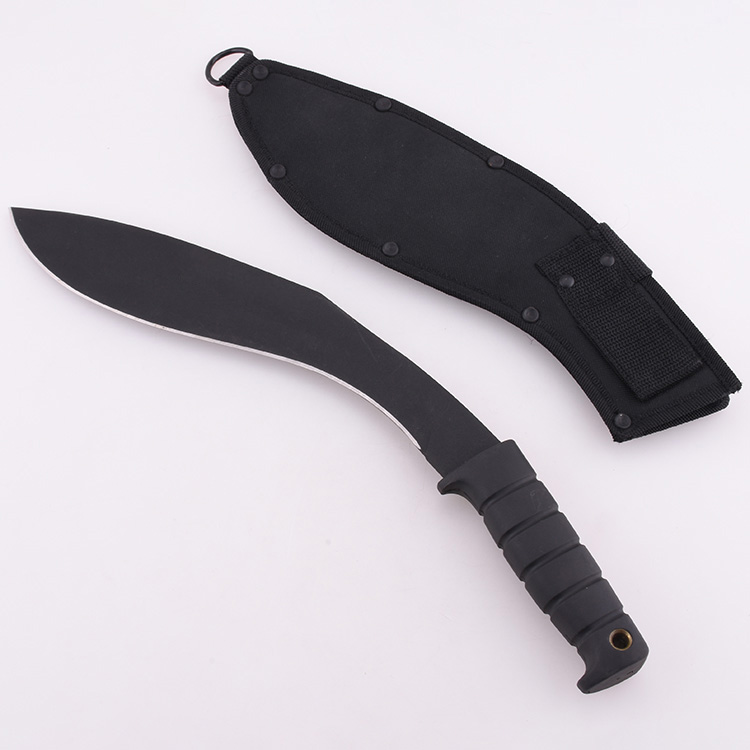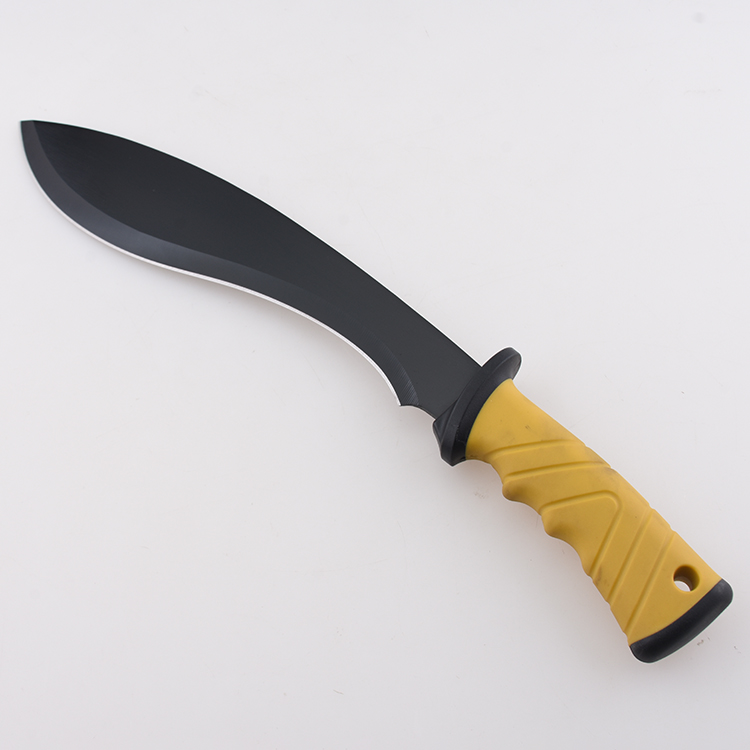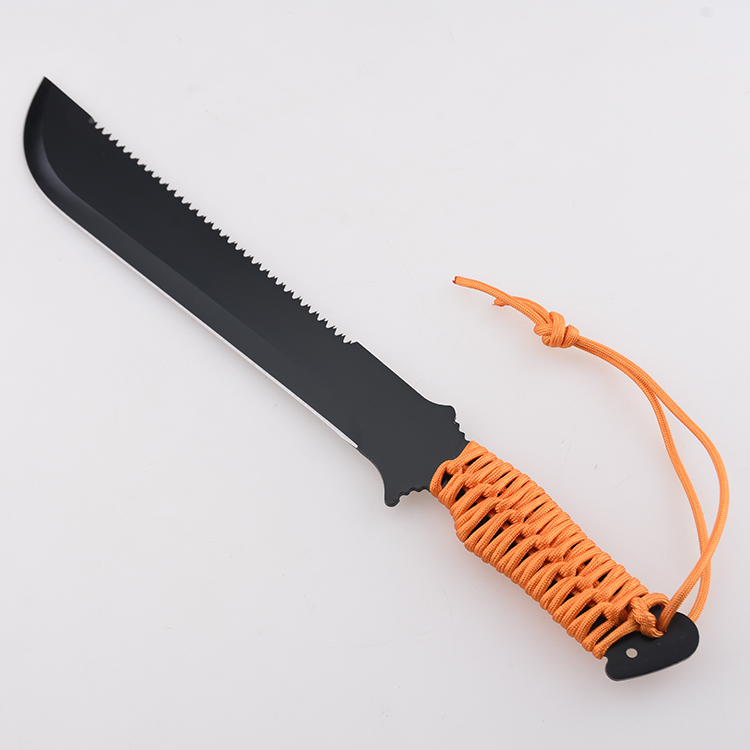The machete is a versatile tool, widely used for clearing brush, chopping wood, and even for farming tasks.
This manual is designed to give you practical tips and advice on how to use a machete effectively and safely.
Whether you are a seasoned tool user or a beginner, understanding how to handle, maintain, and store your machete properly can make all the difference.
In this guide, you’ll find key information to help you get the most out of your machete while staying safe.
Understanding the Machete
A machete is a broad blade that can be used for farming or as a weapon.
Historically, it was important for harvesting sugar cane in America and the Caribbean but could also be used in slave rebellions, symbolizing the unstable society of slavery.
Machetes have blades that are usually 30 to 66 centimeters long and less than 3 millimeters thick.
The word “machete” comes from the Spanish language, possibly from “macho,” meaning sledgehammer, or “machaera,” a Greek and Roman term.
The first machetes were made in Spain and were hand-crafted before the 18th century. In some English-speaking Caribbean countries, these tools are called “cutlasses.”
Basic construction and common types of machetes
Machetes come in various shapes and sizes, each designed for specific tasks and environments. They have evolved, adapting to the needs and traditions of different regions. The most important factor in choosing a machete is finding one that feels comfortable and suits your needs.
Barong Machetes
Barong machetes have a unique leaf-shaped blade that is usually sharpened on one side. Originating from the Philippines, they were historically used by tribes for hunting and livestock slaughter. These machetes were feared by European colonizers for their ability to cut through rifle barrels.
Bush Machetes
Bush machetes, also known as Latin-style machetes, are all-purpose tools with a straight back blade. They are evenly weighted, portable, and great for cutting green vegetation. They are widely used in Latin America for various cutting tasks.
Bolo Machetes
Bolo machetes are popular in Southeastern Asia and are commonly used for farming. They are excellent for harvesting narrow row crops like rice and soybeans. The blade has a distinctive bulge that adds weight, providing extra chopping power.
Hawkbill Machetes
Hawkbill machetes have a curved or hooked blade that can be sharpened on both sides of the inside of the curve. The sharpened tip is useful for piercing hard materials, while the inner curve is great for cutting tall grasses.
Kukri
Kukri machetes have a distinctive blade with three parts: a pointed tip for stabbing, a wide midsection for chopping, and a narrow area near the handle for whittling. Originating from Nepal, the Kukri is a versatile tool used for various tasks in Central Asia.
Blade shape and size
The shape and size of a machete blade greatly affect its performance and suitability for different tasks. Machete blades vary in length from 30 to 66 centimeters and can be straight, curved, or specially designed like a hooked tip.
A longer blade covers more area with each swing, ideal for clearing large patches of vegetation, while a shorter blade offers better control for detailed work. Blade thickness also matters; thinner blades are lighter and easier to handle but might not be as durable for heavy-duty chopping.
Handle design and materials
The handle of a machete is just as important as the blade.
A good handle should be comfortable to hold and provide a secure grip, reducing the chance of slipping during use. Handles are made from various materials like wood, plastic, and rubber.
Wooden handles offer a classic look and feel but need some care to prevent cracking. Plastic handles are durable and often include textured surfaces for a better grip.
Rubber handles provide excellent grip, especially in wet conditions, making the machete easier to control.
Types and functions of machete sheaths
Machete sheaths serve multiple essential functions, protecting both the user and the blade.
Typically made from materials like leather, nylon, or plastic, sheaths help prevent accidental injuries by covering the sharp edges of the blade when not in use.
They also protect the blade from environmental elements, reducing the risk of rust and corrosion.
Some sheaths come with additional features such as belt loops or straps, making it easy to carry the machete securely while on the move.
Uses of Machetes in Various Environments and Activities
Machetes are practical tools that can be used in different settings and for many tasks. Here are some common uses:
- Forestry and Landscaping: Clearing brush, cutting small trees, and trimming plants.
- Farming: Harvesting crops like sugar cane, corn, or rice.
- Gardening: Removing weeds, cutting through tough stems, and pruning.
- Camping and Hiking: Cutting firewood, building shelters, and preparing food.
- Survival Situations: Creating shelters, hunting, and self-defense.
- Household Tasks: Chopping meat, opening coconuts, and other heavy-duty cutting jobs.
Choosing the Right Machete
Blade length and weight
When choosing a machete, consider the length and weight of the blade as these factors greatly impact its functionality.
A longer blade, which can range between 50 to 66 centimeters, is ideal for clearing wide areas of vegetation like thick brush or tall grass, as it covers more ground with each swing.
However, longer blades can be heavier and require more strength to handle.
On the other hand, shorter blades, around 30 to 45 centimeters, offer more control and precision, making them suitable for detailed tasks such as trimming plants or cutting through dense undergrowth.
For example, a shorter blade would be handy in a home garden for pruning or shaping hedges. The weight of the blade also plays a crucial role; a lighter blade is easier to wield for extended periods but may not be as effective for heavy-duty chopping.
Handle material and comfort grip
Handles are made from various materials such as wood, plastic, and rubber, each offering unique advantages.
Wooden handles provide a traditional and aesthetically pleasing look but require maintenance to avoid splintering or cracking.
For instance, an old-fashioned wooden handle on a family heirloom machete might need regular oiling to stay in good condition.
Plastic handles are durable, resistant to weather conditions, and often feature textured surfaces for a firm grip.
Rubber handles are practical for everyday use, especially in damp environments. They provide the best grip in wet or sweaty conditions, making them perfect for tasks like cutting through slippery vegetation.
A well-designed handle with a comfortable grip reduces hand fatigue and slippage, enhancing overall safety during use.
Durability and portability of the sheath
A sheath is an essential accessory for a machete, enhancing both safety and blade longevity.
Sheaths can be made from leather, nylon, or plastic.
Leather sheaths are durable and offer a classic look but might be heavier and require more care to prevent drying out or cracking.
For example, a high-quality leather sheath would be suitable for a collector or someone who values traditional craftsmanship.
Nylon sheaths are lightweight, resistant to moisture, and often come with extra pockets or loops for carrying additional tools, making them a versatile option for outdoor activities.
Plastic sheaths are robust, weather-resistant, and easy to clean, ideal for rough environments where the machete might be exposed to mud or water.
Some sheaths feature belt loops or shoulder straps, allowing the user to carry the machete comfortably and conveniently while keeping their hands free for other tasks.
Different types of machetes and their specific uses
Jungle machete
A jungle machete is a robust cutting tool designed for navigating dense vegetation in tropical environments.
It typically features a broad, heavy blade with a slight curve, allowing it to chop through thick foliage and small branches effectively.
Jungle machetes often have a durable construction to withstand rough conditions and prolonged use in harsh environments.
They are essential for survival and outdoor activities like camping, hiking, and bushcraft.
Outdoor survival machete
An outdoor survival machete is a versatile and sturdy tool, essential for anyone venturing into the wilderness. This type of machete typically has a mid-sized blade, combining the best features of various designs to handle multiple tasks.
For instance, an outdoor survival machete might be used to:
- Build shelters: Whether you’re cutting branches for a lean-to or slicing vines for a makeshift rope, a survival machete is invaluable.
- Gather and prepare firewood: Its sharp blade can split logs, cut kindling, and even shave wood for tinder.
- Hunt and prepare food: In a survival situation, you can use the machete to process game or fish, cut through tough plant materials, and prepare meals.
These machetes often have ergonomic handles to reduce hand fatigue during long use and durable sheaths to protect both the user and the blade.
For example, a rubber handle provides a firm grip even when wet, and a nylon sheath with belt loops makes carrying the machete easier.
Overall, the outdoor survival machete is a versatile tool designed to handle various challenges in the wild.
Everyday work machete
An everyday work machete is designed for practical, routine tasks around the home, garden, or farm.
This type of machete typically has a medium-length blade, around 40 to 50 centimeters, and is lightweight enough for extended use without causing fatigue.
Its blade is often made from high-carbon steel or stainless steel, which ensures durability and ease of sharpening. The design prioritizes versatility, allowing the machete to perform a wide range of duties efficiently.
For example, an everyday work machete can be used for chopping compost materials, trimming hedges, or cutting through thick weeds in the garden.
It is also handy for farm work, such as harvesting crops like corn or sugar cane and clearing brush to maintain open pathways.
Safe Use of the Machete
Inspection before use
Before using a machete, make sure to inspect it. This helps prevent accidents and improves the tool’s effectiveness.
- Examine the blade for damage: cracks, chips, or heavy rust.
- Check blade sharpness: a dull blade needs more force and can slip.
- Inspect the handle: look for wear, looseness, or damage that affects grip and control.
- Look at the sheath: check for tears or defects that keep it from covering the blade safely.
Correct grip posture
- Hold the machete firmly: Grasp the handle with your dominant hand, using a firm but not tense grip. This ensures you have control over the blade while minimizing hand fatigue.
- Place your thumb and index finger correctly: Your thumb should wrap around one side of the handle, and your index finger should rest comfortably along the opposite side, just above where the handle meets the blade. This positioning provides stability and precision.
- Keep your other fingers relaxed: The rest of your fingers should wrap around the handle naturally, without squeezing too tightly. This helps you maintain a secure grip without cramping your hand.
- Face the blade away from you: Make sure the sharp edge of the blade points in the direction of your cut, away from your body. This minimizes the risk of injury and ensures efficient cutting.
- Bend your elbow slightly: This allows for better control and force distribution during cutting or chopping motions. A slightly bent elbow also reduces strain on your arm and shoulder.
- Position your wrist straight: Avoid bending your wrist excessively. Keeping it straight helps direct the power from your arm into the blade, making your cuts more effective and reducing wrist strain.
- Adjust your grip as needed: Depending on the task, you might need to change your grip. For precise tasks, hold the handle closer to the blade; for powerful chopping, position your hand closer to the end of the handle for better leverage.
How to avoid common dangers when using a machete
- Avoid excessive swinging: Control your movements to prevent accidental cuts or injuries. Limit the swing to the necessary range for effective cutting.
- Be aware of your surroundings: Always check the area around you for obstacles, people, or animals before swinging the machete. Ensure a clear and safe operating space.
- Maintain a proper stance: Stand with feet shoulder-width apart and keep a balanced posture. This helps you stay stable and reduces the risk of losing control.
- Keep the blade sharp: A sharp machete requires less force and provides better control. Regularly sharpen the blade to maintain its efficiency.
- Use protective gear: Wear gloves to protect your hands, and consider using safety glasses to shield your eyes from debris. Long sleeves and pants can also offer additional protection.
- Store the machete safely: When not in use, store the machete in its sheath and keep it out of reach of children. Avoid leaving it exposed or unattended in work areas.
- Follow proper maintenance routines: Clean the blade after each use to prevent rust and damage. Regularly inspect the machete for any signs of wear and address issues promptly.
- Use the right technique: Learn and practice the correct cutting techniques to minimize the chance of mistakes. Proper handling reduces the likelihood of accidents.
- Never use a machete when tired or impaired: Tiredness or impairment can significantly reduce your control and judgment. Ensure you are alert and focused when using a machete.
Basic Techniques for Using a Machete
How to effectively cut and chop different materials
Trees and shrubs
Cutting trees and shrubs using a machete requires proper technique to ensure safety and effectiveness. Position the machete at an angle and use a controlled, steady motion to make diagonal cuts into the wood. This approach maximizes the blade’s cutting power and reduces the effort needed. Always start with smaller branches and work towards larger ones to prevent the blade from getting stuck.
Vines and herbaceous plants
When dealing with vines and herbaceous plants, a swift, sweeping motion works best. Hold the machete firmly and slice through the plants at their base, close to the ground. This technique ensures a clean cut and helps you manage the overgrowth more efficiently. Be cautious of the surrounding vegetation to avoid damaging any plants that you do not intend to cut.
Thick weeds
To cut thick weeds, use a chopping motion similar to the one used for trees and shrubs. For best results, aim to cut the weeds at their thickest part, typically near the base. A sharp blade will make the task easier, so ensure your machete is well-maintained. Clear away the cut weeds frequently to have a clear working area.
Long grass
Cutting long grass is much easier with a large, sweeping motion. Swing the machete in a wide arc, targeting the grass at mid-height. This method reduces resistance and allows you to cover more area quickly. Regular sharpening of the machete ensures smooth and efficient cuts. Always watch your footing to maintain balance while working on uneven ground.
Maintenance and Care of the Machete
Cleaning methods for the machete
Proper cleaning of your machete is essential to keep it in good condition and extend its lifespan. After each use, make sure to follow these steps to clean your machete:
- Rinse the blade: Use water to remove dirt and sap. If needed, use mild soap.
- Dry completely: Wipe the blade dry with a clean cloth to prevent rust.
- Oil the blade: Apply a thin layer of oil to the blade to create a protective coating against moisture.
- Clean the handle: Wipe down the handle with a damp cloth and dry it thoroughly.
- Store properly: Keep the machete in its sheath and a dry place.
Sharpening and honing the machete
To keep your machete in top shape, regular sharpening and honing are important. Here’s how you can do it:
- Choose a sharpening tool: You can use a sharpening stone, file, or a dedicated machete sharpener.
- Secure the machete: Place the machete on a stable surface or secure it with a clamp to prevent it from moving while you sharpen it.
- Position the blade: Hold the machete at a slight angle (usually around 20 degrees) to the sharpening tool.
- Sharpen the blade: Move the sharpening tool along the edge of the blade in one direction, from the base to the tip. Repeat this process several times on one side before switching to the other side of the blade.
- Check for evenness: Make sure both sides of the blade are equally sharpened. This ensures that the edge is balanced and strong.
- Hone the blade: After sharpening, use a honing tool or fine-grit stone to polish and refine the edge. This step smooths out any roughness and makes the blade razor-sharp.
- Clean the blade: Wipe the blade clean with a cloth to remove any metal filings or debris.
- Apply oil: Lightly oil the blade to protect it from rust and keep it in good condition.
Regular sharpening and honing will keep your machete effective and ready for use, ensuring that it cuts cleanly and efficiently every time.
Best practices for storing the machete
- Clean the machete before storage: Always clean the blade and handle after each use to remove dirt, sap, and moisture.
- Dry the blade thoroughly: Make sure the blade is completely dry to prevent rust and corrosion.
- Apply a thin coat of oil: Lightly oil the blade to create a protective layer against moisture.
- Use a sheath: Store the machete in its sheath to protect the blade and prevent accidental cuts.
- Store in a dry place: Keep the machete in a cool, dry location to avoid exposure to humidity.
- Keep out of reach of children: Store the machete in a secure place where children cannot access it.
- Avoid leaving it exposed: Do not leave the machete unattended or exposed in work areas to prevent accidents and damage.
Advanced Techniques and Applications
Using a machete for jungle traversal involves advanced techniques like clearing dense vegetation efficiently by using slicing and chopping motions. Professionals often use their machetes to create paths, clear obstacles, and mark trails. It’s crucial to maintain a firm grip and be mindful of safety to avoid accidents while cutting through thick undergrowth.
Multifunctionality of the Machete in Outdoor Survival
In outdoor survival, a machete serves multiple purposes. It can be used to craft tools and shelters by cutting and shaping wood or other materials. Machetes are also essential for food preparation and acquisition, such as cutting fruits, opening coconuts, or even hunting small game. Their versatility makes them indispensable in emergency situations where resources are limited.
Crafting Tools and Shelters
Machetes are adept at crafting tools and shelters in outdoor survival scenarios. They can be used to cut branches for building shelters, shape wooden stakes for tents, or carve tools like spears and fishing hooks from wood. Their sharp blades make precise cuts, essential for creating functional and sturdy structures in the wilderness.
Food Preparation and Acquisition
In outdoor survival, machetes play a vital role in food preparation and acquisition. They can be used to harvest fruits, vegetables, and edible plants by cutting through tough stems and branches. Machetes are also useful for opening coconuts, gutting fish, and preparing small game for cooking, making them indispensable for securing food in the wild.
Carrying and Use in Travel
When traveling with a machete, it’s important to be mindful of both safety and efficiency. A well-prepared adventurer considers the best ways to transport their tool and how to use it effectively in varied environments.
Below are some suggestions and guidelines for carrying and using a machete during travel and outdoor activities.
Suggestions for Carrying a Machete During Travel and Outdoor Activities
When carrying a machete, always use a secure sheath to cover the blade. This not only protects the blade from damage but also prevents accidental cuts.
For ease of access, you can attach the sheathed machete to your belt or pack with strong clips or straps. If flying, check airline regulations, as most do not allow machetes in carry-on luggage; they usually belong in checked baggage.
How to Effectively Utilize a Machete in Different Environments
Using a machete can vary greatly depending on the environment you are in. Here’s how to make the most out of your machete in three distinct settings:
Tropical Rainforests
In tropical rainforests, your machete is invaluable for cutting through dense vegetation and thick undergrowth. Use it to clear paths by swinging it in a controlled, rhythmic motion. This will help you avoid getting tangled in vines and branches. It’s also useful for creating makeshift shelters and clearing an area to set up camp.
Desert Environments
While deserts may not have much vegetation, a machete can still be useful. It can help you dig shallow holes to access underground water or set up tent stakes. Use it to cut branches from the scarce desert plants for building a shade structure or firewood. Always be careful with your swings to conserve energy in the hot, arid conditions.
Mountains and Forests
In mountainous regions and forests, a machete is handy for both cutting and carving. Use it to clear branches obstructing paths or to create walking sticks to aid in your hike. You can also use it to build shelters, cut firewood, and even to carve tools from wood. Ensure you maintain a steady grip and balance, especially on uneven ground, to prevent accidental injuries.
Заключение
Machetes are versatile tools for tasks like clearing jungle paths and crafting shelters in survival situations. Proper care is essential for safety and effectiveness. Clean, dry, oil, and store your machete securely to prolong its lifespan and utility.
Understanding different techniques and uses in various environments, such as rainforests, deserts, and mountains, enhances their effectiveness and ensures safe, responsible use.
As a leading knife manufacturer, Shieldon provides OEM (Original Equipment Manufacturer) and OBM (Original Brand Manufacturer) services for various knives.
We specialize in creating high-quality, durable blades. Whether you need a custom machete or other cutting tools, Shieldon can meet your needs.
Partnering with Shieldon means you get top-tier craftsmanship and innovative designs tailored to your requirements. We are committed to quality and functionality, ensuring our products are practical and reliable for both recreational and survival purposes.
Часто задаваемые вопросы
What activities or environments are machetes typically used for?
Machetes are commonly used in a variety of activities and environments, including:
- Jungle and Forest Navigation: Clearing dense vegetation, creating paths, and marking trails.
- Agricultural Tasks: Harvesting crops like sugarcane and clearing fields.
- Outdoor Survival: Crafting tools and shelters, preparing food, and securing resources.
- Gardening and Landscaping: Trimming hedges, cutting through brush, and removing unwanted plants.
- Camping and Hiking: Building shelters, gathering firewood, and carving tools.
- Emergency Situations: A versatile tool for cutting through obstacles and performing various survival tasks.
In each of these scenarios, machetes are valued for their ability to efficiently handle tasks that require cutting, chopping, and slicing through tough materials.
What key factors should be considered when choosing a machete?
When choosing a machete, consider the following key factors:
- Blade Material: High-carbon steel and stainless steel are popular choices. High-carbon steel is durable and holds a sharp edge well, while stainless steel is resistant to rust and corrosion.
- Blade Length: Choose a blade length that suits your needs. Longer blades (18-24 inches) are ideal for clearing vegetation, while shorter blades (10-18 inches) offer more control for detailed tasks.
- Blade Thickness: Thicker blades are more robust and suitable for heavy-duty tasks, while thinner blades are lighter and more agile, making them better for precision work.
- Handle Design: Ensure that the handle provides a comfortable and secure grip. Look for ergonomic designs with non-slip materials like rubber or textured grips.
- Weight and Balance: The machete should have a balanced weight that feels comfortable and manageable in your hand. A well-balanced machete reduces fatigue and increases control.
- Blade Shape: Different shapes are suited for different tasks. Straight-back blades are versatile, while curved or kukri-style blades excel in chopping and splitting.
- Intended Use: Consider what tasks you’ll be using the machete for. Specific machetes are designed for tasks such as vegetation clearing, woodworking, or survival scenarios.
- Price and Brand: Ensure the machete offers good value for money. Trusted brands often provide better quality and durability.
Taking these factors into account will help you select a machete that suits your specific needs and ensures effective performance.
How does the blade length and weight of a machete affect its use?
How does the blade length and weight of a machete affect its use?
The length and weight of a machete’s blade influence its effectiveness for various tasks. Longer blades (18-24 inches) are ideal for clearing dense vegetation and tall grass, offering more reach and cutting power.
They also excel at chopping thicker branches. Shorter blades (10-18 inches) provide better control and precision, perfect for detailed work like carving and fine cutting.
A heavier machete delivers powerful cuts, ideal for chopping wood, but may cause fatigue with prolonged use. A lighter machete is easier to handle and reduces fatigue, enhancing precision, though it might not be as effective for heavy-duty chopping. Balancing blade length and weight for the tasks ensures optimal performance and comfort.
What safety checks are needed before using a machete?
Before using a machete, check for damage or rust on the blade. Ensure the handle is secure and free of cracks to prevent slippage. Sharpen the blade for efficient cutting and ensure it has no nicks or dents. Wear protective gear like gloves and eye protection. Inspect the area for obstructions or people within the swing radius for safe operation.
How can one properly grip and swing a machete for increased efficiency?
To grip and swing a machete efficiently, follow these steps:
- Grip: Hold the handle firmly with your dominant hand, using a comfortable, secure grip. Place your thumb on one side and wrap your fingers around the handle. If using both hands, position the non-dominant hand slightly above the dominant hand for added control and power.
- Stance: Stand with your feet shoulder-width apart. Position your dominant foot slightly forward to maintain balance.
- Swing: Use your shoulder and upper arm to start the swing, not just your wrist or elbow. This spreads the force more effectively and reduces joint strain. Keep your wrist straight and follow through to ensure a clean cut.
- Angle: Strike with the middle portion of the blade, not just the tip. This ensures a stronger, more efficient cut. Maintain a slight angle when striking to maximize the cutting edge.
- Follow-through: After hitting the target, let the machete continue its motion smoothly. Avoid abrupt stops or changes in direction to stay in control and prevent injury.

